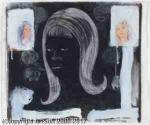Kerry James Marshall
Kerry James Marshall
Στυλ: Existential Art; Expressionism; Primitivism;
Βιογραφία:
Kerry James Marshall is an American artist born in Birmingham, Alabama. He grew up in South Central Los Angeles and now lives in Chicago, Illinois, where he previously taught at the School of Art and Design at the University of Illinois at Chicago. He is a 1978 graduate of Otis College of Art and Design. An exhibition of his work, Kerry James Marshall: Mastry, was assembled by the Museum of Contemporary Art in 2016.
Although he currently lives and works in Chicago, Illinois, his time spent in the Watts neighborhood of Los Angeles, California where the Black Power and Civil Rights movements had a significant impact on his paintings. Strongly influenced by his experiences as a young man, he developed a signature style during his early years as an artist that involved the use of extremely dark, essentially black figures. These images represent his perspective of African Americans, specifically black men with separate and distinct inner and outer appearances. At the same time, they confront racial stereotypes within contemporary American society. This common theme appeared continuously in his work throughout the subsequent decades, especially in the 1980s and 1990s and still appears in his most recent works.
While earning his B.F.A. from Otis College of Art and Design in Los Angeles, he worked not have a representational image or a specific story to tell," over abstraction. However, Marshall works to find a balance to retain political content relevant to the Civil Right Movement, the Watts Race Riots, and contemporary African-American experiences.
Marshall is known for large-scale paintings, sculptures, and other objects that take African-American life and history as their subject matter. His work often deals with the effects of the Civil Rights movement on domestic life, in addition to working with elements of popular culture. In a 1998 interview with Bomb Magazine, Marshall observed,
Black people occupy a space, even mundane spaces, in the most fascinating ways. Style is such an integral part of what black people do that just walking is not a simple thing. You've got to walk with style. You've got to talk with a certain rhythm; you've got to do things with some flair. And so in the paintings I try to enact that same tendency toward the theatrical that seems to be so integral a part of the black cultural body.
One work, Rythm Mastr, is a superhero comic book based on African mythology and art set in an urban environment. Some of his other notable works include The Garden Project, which critiques the glorified names of housing projects that conceal desperate poverty and the Lost Boys series, which examines young black men "lost in the ghetto, lost in public housing, lost in joblessness, and lost in literacy."
Marshall's first major solo exhibition, which traveled throughout the country, was organized at the Renaissance Society of the University of Chicago in 1998. His work has been exhibited in many American and international exhibitions, including the Venice Biennale (2003) and the Documenta (1997 and 2007).
In April 2016, Marshall's retrospective Mastry debuted at the Museum of Contemporary Art in Chicago as the largest retrospective to date of Marshall's art, which spanned the artist's 35-year career and included nearly 80 original pieces. In October 2016, the retrospective traveled to the Met Breuer in New York City.
Marshall based several of his pieces in the early 1990s on actual events in American history. One such painting, Voyager, painted in 1992, has special pertinence in a discussion of race issues in the United States because Marshall based it on a "luxury schooner…secretly outfitted to carry African slaves". Symbols of this representation abound, from the two black figures in the boat and the flowers draped around the woman's neck to the contrast between the light and airy clouds and the darkness of the upper background. A skull lies in the water, just beneath the ship, hinting at the doomed future of the Africans, and the unknown woman has an expression of uneasiness. He thus brings to the forefront the irony of a ship with a beautiful, high class appearance and a dark secret purpose, forcing people to think about something they would rather forget.
Marshall explored the concept of black beauty in contrast to Western ideals with his painting La Venus Negra. The figure, this time a nude woman, literally blends into her dark surroundings, her sensuous shape barely discernible. Yet once the viewer looks closely, her curvaceous figure evokes a womanly power only enhanced by the deep black of her skin. Untitled (Supermodel), in the collection of the Honolulu Museum of Art, portrays a black woman trying to look like blond Caucasian models. The work also references self-portraits of the artist, who adorns himself with pale lipstick and a long blond wig.
As Marshall admits, he himself "had not considered that a black woman could be considered a goddess of love and beauty," but with this painting he proves its possibility. He challenges the classic perception of a goddess as a white woman with long flowing hair, speaking again to the issue of African American identity in the Western world. This concept has more meaning when looking at the African pattern on the top quarter of the background. With this addition, he references the movement begun during the Harlem Renaissance to incorporate traditional African aesthetics into African American art. In an attempt to reconcile the African art and Western ideals, Marshall places both in his painting. Thus he highlights the search for a black identity that involves all aspects of their ancestral history and their current situation. Although African Americans may feel connected to two differing cultures, Marshall's painting of a classically Western figure represented with a new black aesthetic brings the two together, showing that they can live in harmony.
More...
Wikipedia link: Click Here














